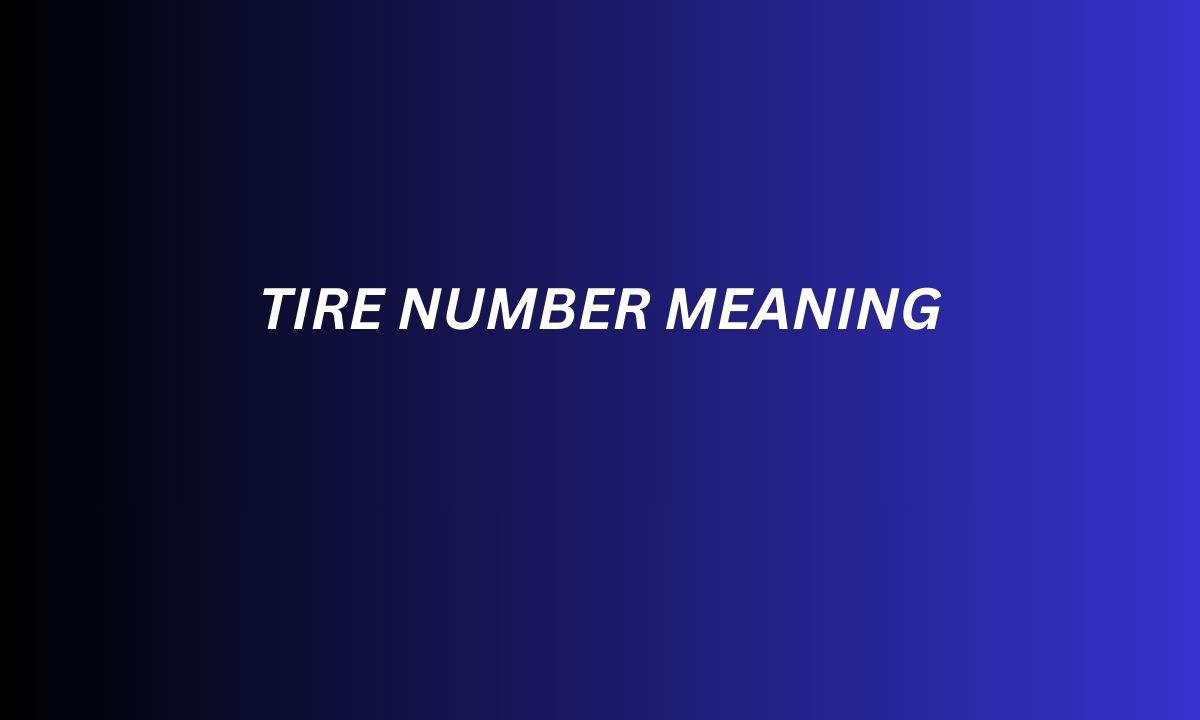Understanding the tire number meaning is essential for drivers who want to ensure safety, efficiency, and proper performance on the road. The sequence of numbers and letters printed on your tire sidewall may look random, but each part carries important information.
When drivers see a code like “P215/65R15 95H,” they often overlook its significance. In fact, these tire numbers reveal vital details such as tire type, width, aspect ratio, construction, wheel diameter, load index, and speed rating.
By decoding the tire number meaning, vehicle owners gain better control over choosing replacement tires, understanding maintenance requirements, and ensuring compatibility with their vehicle. This knowledge also helps avoid common mistakes that may lead to safety risks or reduced efficiency.
What Does Tire Number Meaning Stand For?
The tire number meaning is a code that provides complete details about the tire’s dimensions, performance, and capacity. For example:
- P215/65R15 95H
- P = Passenger vehicle tire
- 215 = Tire width in millimeters
- 65 = Aspect ratio (height compared to width)
- R = Radial construction
- 15 = Rim diameter in inches
- 95 = Load index (weight capacity)
- H = Speed rating (maximum safe speed)
These numbers are standardized worldwide, meaning anyone familiar with them can understand a tire’s features regardless of brand or model.
Why Tire Number Meaning Matters
Tires are more than rubber circles—they are complex, engineered components designed for safety, performance, and fuel efficiency. Knowing the tire number meaning ensures:
- Safety: Correct load and speed rating prevent blowouts.
- Efficiency: Proper tire size improves fuel economy.
- Longevity: Correct tire choice reduces uneven wear.
- Compatibility: Ensures tires match the vehicle’s specifications.
Failing to follow these codes may cause accidents, poor handling, or legal issues, as many countries regulate tire standards.
Tire Number Meaning in Text
The phrase tire number meaning in text refers to how drivers interpret tire codes written on sidewalls, manuals, or even in online discussions. Understanding the context of these codes allows drivers to translate technical jargon into plain English. For instance, when a friend texts you “Check if your tires are 225/50R17,” the numbers are shorthand for width, height, and wheel size.
Decoding such information in text conversations helps avoid confusion, especially when ordering new tires, checking compatibility, or discussing performance with mechanics.
Exploring “Hiatus Meaning” as a Language Element
Before moving into alternatives, let’s connect with your request to explore hiatus meaning. A hiatus generally means a break or pause, often in speech, writing, or activities. In language, it occurs when two vowel sounds meet in consecutive syllables without a consonant.
Similarly, understanding tire numbers has no room for hiatus—clarity is vital. Just as a pause changes the tone of a sentence, misunderstanding a tire number changes the safety and efficiency of your vehicle. Now, let’s explore polite, professional, and casual alternatives to the expression “hiatus meaning” in everyday text.
Polite, Professional, and Casual Alternatives to “Hiatus Meaning”
Here are 15 well-crafted examples you can use instead of the phrase “hiatus meaning,” each suitable for different contexts.
- Break in Activity – Used in everyday conversations to describe a pause in routine.
Example: “There was a break in activity during the workshop.” - Temporary Pause – Neutral, clear, and suitable for professional emails.
Example: “Our meeting will include a temporary pause for refreshments.” - Interruption – Slightly formal, useful for academic or work contexts.
Example: “The project faced an unexpected interruption in its timeline.” - Rest Period – Friendly and casual, often applied in informal settings.
Example: “Let’s take a short rest period before we continue.” - Brief Suspension – Polite and professional, used in official reports.
Example: “The service will undergo a brief suspension for maintenance.” - Time Gap – Neutral and easy to understand, suitable for spoken English.
Example: “There was a time gap between the two sessions.” - Lull – Slightly literary, good for polished writing.
Example: “A lull in conversation gave her time to think.” - Recess – Formal or casual depending on context, often linked to schools or courts.
Example: “The judge declared a recess for lunch.” - Interval – Formal and widely accepted in cultural or performance settings.
Example: “The play included a short interval before the final act.” - Downtime – Casual and commonly used in tech or workplace language.
Example: “The website experienced downtime due to updates.” - Breaktime – Friendly and informal, often used in schools or workplaces.
Example: “It’s breaktime—let’s grab some coffee.” - Intermission – Formal, especially in theater, cinema, or structured events.
Example: “The intermission lasted fifteen minutes.” - Rest Break – Polite and neutral, widely understood in workplaces.
Example: “Drivers must take a rest break every few hours.” - Gap in Progress – Professional, useful in project management contexts.
Example: “There was a gap in progress due to funding delays.” - Pause in Flow – Flexible, professional, and casual depending on tone.
Example: “We noticed a pause in flow during the discussion.”
Each alternative allows flexibility in tone depending on the situation—whether formal, casual, or polite.
How to Choose the Right Expression
- Formal Settings: Words like intermission, interval, brief suspension are best.
- Professional Communication: Use temporary pause, gap in progress, interruption.
- Casual Conversations: Prefer downtime, breaktime, rest period.
Context decides the best choice. For instance, in an office email, saying “temporary pause” sounds more professional than “downtime.” But when chatting with friends, “downtime” feels more natural and relaxed.
The Connection Between Tire Numbers and Language Nuance
Just as understanding the correct word for “hiatus” depends on context, knowing the tire number meaning requires context too. A driver must interpret whether “95H” refers to speed or load. Similarly, choosing “interval” instead of “breaktime” changes the tone of communication.
Language and tire codes both rely on clarity, precision, and audience awareness. Misusing either may cause confusion—one in conversation, the other on the road.
Conclusion
The tire number meaning reveals critical details about your vehicle’s tires, ensuring safety, compatibility, and efficiency. By learning to decode tire numbers, you make informed choices that protect your vehicle and passengers.
At the same time, language demonstrates similar precision. Exploring hiatus meaning and its alternatives shows us how word choice can alter tone, politeness, and clarity. With 15 practical examples, you now have a strong set of expressions to use in different contexts.
Just as a tire number prevents misunderstandings on the road, the right word prevents miscommunication in conversation.

Elizabeth crafts heartfelt messages for every occasion—anniversary wishes, love notes, prayers, thank-yous, and inspirational greetings—bringing warmth, joy, and connection to your special moments.










